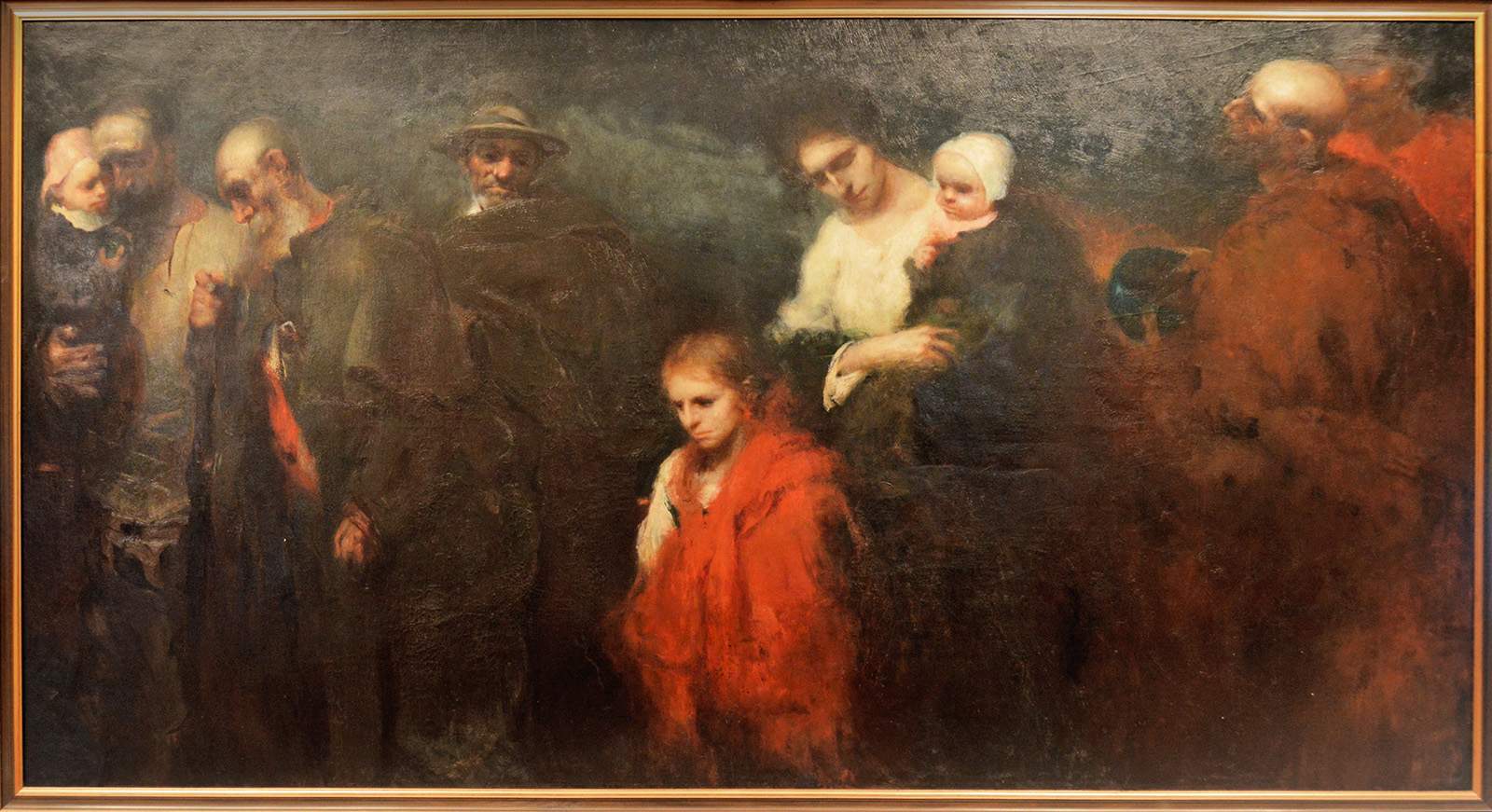A masterpiece by Felice Carena (Cumiana, 1879 - Venice, 1966), The Wayfarers of about 1907, was donated to the Ducal Palace in Mantua by a collector, Dr. Emilio Zanetti (in memory of his brother Antonio Zanetti) and the Zanetti family. By virtue of its dating, subject matter, and the specific desire to enhance the work in an appropriate context, the painting was displayed in the reception rooms of the Mantua Prefecture. It is a work of remarkable quality, immediately appreciated by critics and the result of the hand of a renowned artist.
Felice Carena was born in Cumiana (Turin) on August 13, 1879, to a father who was a clerk and a mother who was a teacher. He studied at the Accademia Albertina in Turin. In works from the early decades of the 20th century, his art is directed toward the Secessionist and Symbolist temperament, with predilections for Arnold Böcklin and Eugène Carrière. In the 1930s he was among the most celebrated artists in Italy, as writer Raffaello Franchi attested in 1936: “(...) to say that Felice Carena is today one of the most conspicuous Italian painters, is something absolutely obvious.”
There is an alternative version of the painting, also by Carena, of similar title and subject, preserved at the Gallery of Modern Art in Udine, dated 1907. The work originated in the context of Symbolist and Populist painting. A soft, dim light creates a serene, almost artificial-light tone, from which emerge brown and greenish hues and the bright red of the little girl’s dress in the foreground. The social theme emerges powerfully, finding expression in the anonymous protagonists, helpless victims of their poverty: a humanity resigned to a condition of suffering without redemption. The artist painted this work when he was not yet in his thirties, while hanging out with the poet Giovanni Cena, a passionate spreader of humanitarian socialism. Yet, despite the work’s social commitment, when the Russian writer Maksim Gor’kij, considered one of the fathers of socialist realism, saw it, in Rome in the early 1900s, he told the painter that “these poor people are not poor enough,” as they are transfigured by art into something great and poetic. The fortune of the composition, at the time highly praised by critics to the point of being judged “among the strongest pieces of painting that have been painted in Italy for many years” (Mario Lago, 1910), explains the existence of a second redaction.
“The ’gifts’ bring joy and for that,” says Gerlando Iorio, Prefect of Mantua, “they require dutiful as well as heartfelt thanks: to the Zanetti family for the sensitivity and attention given to the Mantuan community; to Dr. L’Occaso, Director of the Museum of the Ducal Palace in Mantua, for curating the permanent exhibition of the work in the rooms of the Mantuan Prefecture. What better location, if not in the Palazzo del Governo, could have the painting I Viandanti by Felice Carena, among the most significant artists of the early 20th century. The strongly social aspects investigated by the author, in fact, are often at the center of prefectural action in the territory and characterize its function. The subject of the composition, however, cannot convey a feeling of mere sadness. On the contrary, the work transfers, in those who can look with a spirit of confidence, a feeling above all of hope. The wayfarers embody the metaphor of the journey, of setting out and connecting with one’s neighbor. The faces of the protagonists convey melancholy and all the weight of the hardship experienced, but the movement, albeit weighted and slow, of the bodies shows a posture that speaks of challenges and courage, that which is necessary to face a path, perhaps difficult and treacherous, such as that of life, which, however, leads to knowledge and education, but also to recognize diversity and the other.”
The presentation to the public took place in the context of the Republic Day celebrations last June 2, constituting one of the most significant moments of the event, together with the dynamic participation of young people strongly desired by Prefect Iorio: on the one hand, the dynamism of the themes related to social issues recalled by the painting; on the other hand, the joy and hope of the young people who carried the tricolor among the people in the city streets.
Image: Felice Carena, I Viandanti (c. 1907; oil on canvas, 160 x 300 cm; Mantua, Prefecture, on deposit from Palazzo Ducale, inv. 123051, Emilio Zanetti donation, in memory of his brother Antonio Zanetti)
 |
| Felice Carena's masterpiece donated to Mantua's Ducal Palace, will be displayed in prefecture |
Warning: the translation into English of the original Italian article was created using automatic tools. We undertake to review all articles, but we do not guarantee the total absence of inaccuracies in the translation due to the program. You can find the original by clicking on the ITA button. If you find any mistake,please contact us.